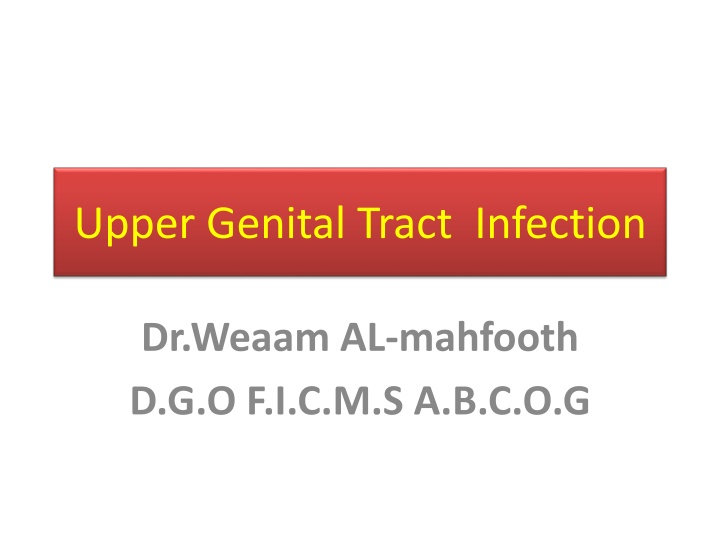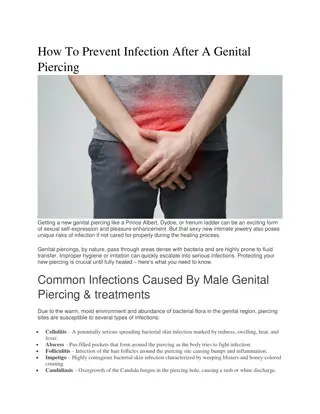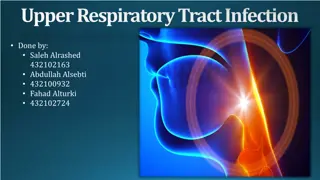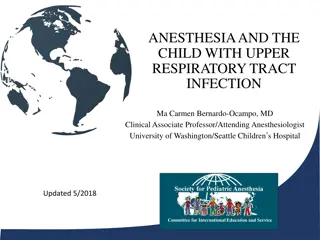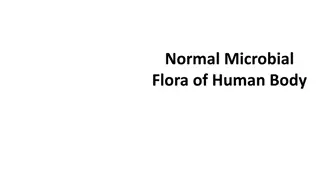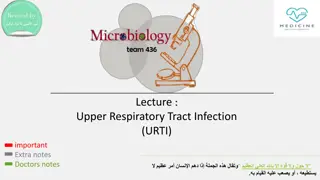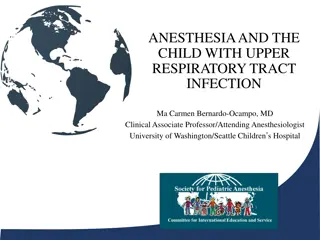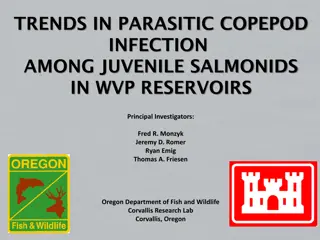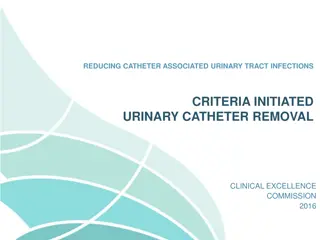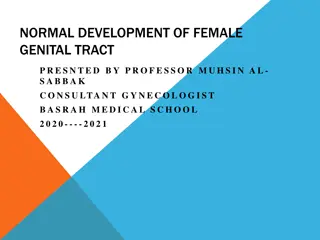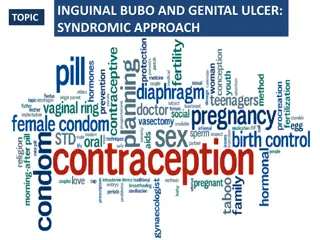Upper Genital Tract Infection
Delve into upper genital tract infections with expertise from Dr. Weaam AL-mahfooth, a specialist in obstetrics and gynecology. Explore the latest insights and treatments for these conditions to enhance your medical knowledge.
Download Presentation

Please find below an Image/Link to download the presentation.
The content on the website is provided AS IS for your information and personal use only. It may not be sold, licensed, or shared on other websites without obtaining consent from the author.If you encounter any issues during the download, it is possible that the publisher has removed the file from their server.
You are allowed to download the files provided on this website for personal or commercial use, subject to the condition that they are used lawfully. All files are the property of their respective owners.
The content on the website is provided AS IS for your information and personal use only. It may not be sold, licensed, or shared on other websites without obtaining consent from the author.
E N D
Presentation Transcript
Upper Genital Tract Infection Dr.Weaam AL-mahfooth D.G.O F.I.C.M.S A.B.C.O.G
Objectives : Definition of pelvic inflammatory disease To determine the risk factors of PID To know the common types of microorganism which cause PID To determine the clinical presentation( How patient with PID present regarding history and examination and most common clinical criteria to diagnose PID Methods of investigations (microbiology ,blood test, surgical and radiological investigations Differential diagnosis of PID To know the complications and follow up of PID How treat patients with PID
Upper Genital Tract Infection Pelvic inflammatory disease (PID) is abroad term used to Cover - upper GTI,i.e. endometrits , parametritis , salpingits and oophorits . These infections usually spread from the vagina or cervix through the uterine Cavity , lymphatic spread may occur , either parametrially or along the surface of the uterus . Infection can also spread from the bowel or Can be blood borne .
Pathogenesis Pathway of Ascendant Infection Cervicitis Endometritis Salpingitis/ oophoritis/ tubo- ovarian abscess Peritonitis 5
Risk factors The risk factors for (PID) strongly reflect those of any sexually transmitted infection . * young age women *multiple sexual partners *lack of condom use *low socio economic status. And black Caribbean black African ethnicity. Cervical mucus provides an important barrier to ascending infection . young women with unovulatory cycle , have thinner mucous and combined with higher rates of ectopi and sexual behavior ,may account, for high rates of (PID)
Risk factors * Many women with (PID) also have bacterial vaginosis with an overgrowth of the normal commensail bacteria in the vagina with loss of vaginal lactobacilli .These same vaginal commensail bacteria are often isolated from upper GT raising the possibility that bacterial vaginosis may lead to(PID) *IUCD may enhance the entrance of organism to the upper genital tract. * Smoking
Microbiology *Organisms associated with pelvic inflammatory disease Aerobic Anaerobic Viruses *Neisseria gonorrhoea Bacteriods spp. H.simplex *Chamydia trachomatis peptostreptococcus spp. Echo virus *Ureaplasma urealyticum clostridium Coxackie *My coplosma genitalium fusobacterium sp *Gardenella Vaginalis *Strep-staphylococci pyogenes *E.Coli *H.influenzae *Mycoplasma hominis *Mycobacterium *Tuberculosis
Microbiology *PID is a polymicrobial infection . Gonorrhea and Chlamydia are the most frequently recognized pathogen *Neisseria Gonorrhea : is gram -ve dipplo coccus which means that when a sample of cervical discharge puts on fixed on a slide the bact . can be seen on MS .as pairs of red Kidney shaped organism . N.Gonorrhea initially infects the CX but ascends to the upper GT in 10-20% of untreated case. Around half of women with G. asymptomatic , but when symptoms are present the vag. discharge thick and purulent . Although isolated gonorrhea from CX supports a dx. of PID, its absence in the lower genital tract cannot exclude infection in the fallopian tube or ovaries.
Microbiology * Chlamydia trachomatis is the commonest bacterial sexually transmitted infection. its unusual bacterium as it requires a host cell to grow , behaving in some ways more like a virus . Chlamydia like gonorrhea , initially infects the cervix and some time also the urethra . It is the commonest identified cause of PID in UK accounting for 30 % of case over 2/3 of women with Chlamydia are asymptomatic.
Histopathology *As infection ascend into the uterus . endometritis it's develops , plasma cells are seen on endomatrial biopsy and germinal centers may develop with Chlamydia infection . Endomatiritis is usually seen in association with IUCD or following abortion and delivery . The histological features include presence of plasma and lymphoid cells and polymorphoneaclur cell with lumen of endometrial gland . The First stage of salpingitis involves mucosal inflammation with swelling , redness , polymorphonuclear cells invade the submucos following by mononucloear and plasma cells .
Histopathology Inflammatory exudates fills the lumen of tubes and adhesion develops. Inflammation extend to serosal surface and pus exudes to ovaries and adnexia with pelvic peritonitis, all the organs are congested with multiple adhesions producing an inflammatory mass . Fixed retroverted uterus . Hydro salpinex is caused by accumulation of fluid with tubes if infected the pyosalpinex results. ** In Acute infection it is usually bilateral . Macroscopic examination swollen and erythematic. Pus may escape from tube ostium per tubular adhesive.
On Histology the changes of acute inflammation are involving mucosa , muscle, coat and serosa. The lumen of tube becomes distended with oedema , blood , necrotic epithelium and acute inflammatory cells adhesion formation tubal obstruct distorted. In Chronic form tubes becomes grossly distorted with formation hydro salpinx and pyosalpinx . During chronic salpingitis the tubes becomes the thickened fibroses and obstructed. There may be per tubular adhesion with adjacent structure including small bowel and ovary tube ovarian mass and abscess.
Pathogenesis Normal Human Fallopian Tube Tissue Source: Patton, D.L. University of Washington, Seattle, Washington 15
Pathogenesis C. trachomatis Infection (PID) Source: Patton, D.L. University of Washington, Seattle, Washington 16
Symptoms of PID: Pain during intercourse Irregular menstrual bleeding. Back pain Urinary discomfort Pain during a pelvic exam Pain in lower abdominal region disassociated with a period. Can range from subtle &mild to sudden onset of moderate to severe pain Fever Unusual vaginal discharge that may have a foul odor
Clinical presentation The clinical dx of PID is based on the presence of : Lower abdominal pain , usual bilateral , Combined with either adnexial tenderness or Cx. excitation on vaginal examination. A pelvic examination is essential and speculum examination is necessary both to enable a swabs to be taken.
Clinical presentation Other clinical features can support a diagnosis of PID but are not essential . Inter menstrual bleeding . Post Coital bleeding . resulting from endometritis . Deep dysparonia. Abnormal vaginal discharge indicating L G T I . Fever nonspecific and usually in sever and moderate PID. Nausea and vomiting
Clinical presentation The clinical criteria for the diagnosis of PID must include all three of : Abdominal tenderness ( and / or rebound ). Cx. excitation Adnexial tenderness. And one or more of : Gram stain of endo cx . positive for Gonorrhea. Temp > 38 0C. Leackocytosis > 10.000 . Pelvic abscess or inflammatory complex mass by U/S.
Clinical presentation Fitz Hugh Curtis Syndrome Inflammation and infection of the liver capsule ( per hepatitis )affects 10 20 % of women with Gonococcus or Chlamydia PID ,into spillage of tubal infection into RT. paracolic gutter. Patient Complain of RT. upper abdominal pain and have tenderness at the liver edge, sometime accompanied by a hepatic friction rubs.
Differential Diagnosis DDx . Significant features Ectopic pregnancy Menstrual hx , initially unilat. Ovarian pathology Initially unilateral pain , (cyste ,hg.,rupture) often mid cycle pain Appendicitis GIT system , Rt .sided pain. Irritable bowel syndrome Central or left sided pain, no Cx. excitation. U T I Urinary symptom +- loin pain. Inflammatory bowel disease Colicky central or LT sided abdominal pain , bowel symptom.
Investigation 1. Microbiology :- The following microbiology tests should be offered to all women presenting with possible PID Endocervical swab for gonorrhea, is taken and placed into transport media ( either Stuarts or Amies ) The Swab is cultured aerobes for gonorrhea and for anaerobes and arrive at the laboratory within 6 hrs but certainly within 24 hr , otherwise viability rapidly lost .
Investigation Endocervical swab containing endocervical cells not just secretion for Chlamydia nucleic acid amplification testing ( NAAT ) or polymerase chain reaction(PCR) the alternative Chlamydia culture or enzyme linked immunosorbent assay ( ELISA ). The introduction of immunoflourescent or enzyme linked ( ELISA ), Antibodies to detect Chlamydia in clinical specimens make the dx to become widely available If an IUCD is present the device should be removal and sent for examination for Actinomyces and culture .
Investigation If gonorrhea is suspected swab lubricant should be taken from urethra and rectum. Screening for other STD infections offered to women who test positive for gonorrhea or Chlamydia or those who are at high risk for PID.: Ms and or culture for Trichomonus vaginalis . H I V antibody test. Syphilis serology. Blood Test: WBC leacko cytosis and ESR . C . reactive protein. NOT specific for PID CA 125 level.
Investigation 2. Radiological investigation:- The use of abdominal U / S to demonstrate abscess formation . Recently transvaginal U/ S to demonstrated tubo ovarian abscess or cystic and solid collection and allow their management by transvaginal aspiration . TVs in women with PID demonstrated thick fluid filled tubes. In 85% appearance of polycystic ovary and free pelvic fluid and reason for review the solution 4 weeks after therapy.
Investigation 3. Surgical investigation:- The definitive diagnosis for PID was laparoscopy and remain more sensitive than any other investigation. There is : Dilated hyperemic of external tubal surface. Oedema of tubal wall. Sticky excaudate on tubal surface. An invasive procedure it should be reserved for those where there is doubt of Dx of acute PID or when pt. fails to respond to antibiotics within 48 72 hrs.
Results of PID: Can be life threatening Causes complications of conception, pregnancy, & fertility Inflammation of fallopian tubes Scarring of abdominal cavity tissue Scarring of fallopian tubes, causing blockage which can lead to ectopic pregnancy (tubal conception) Diagnosed women have 6-10 times increase of ectopic pregnancy Causes high pregnancy-related deaths among African American
Treatment Recommendation for the choice of antibiotics should related to the severity of clinical sign and should be cover the gonorrhea and Chlamydia and other anaerobes A. Ambulant patient with mild symptom can be R as out patients should cover gonorrhea and Chlamydia and anaerobes. It is usually prescribe: 1. Doxocycline 100 mg twice / day for 7 10 days 2. Alternative choice is oflaxocine 400 mg twice / day for 7 10 days. 3. OR single dose (( oral )) Azithromycine 1 gm. plus 5 days of Metronidazal 400 mg twice / day .
Treatment B. Patients who are systematically unwell or in whom a tubal abscess is suspected should be admitted to hospital and start I. V. parental AB" Intravenous 2nd or 3rd generation cephalosporin OR Augamentin And I. V. metronidazol together with I.V. gentamicine if there has been Contamination with bowel Content or patient seriously ill. And it's essential that 2 weeks course of doxycycline is prescribed to eradicate any possible Chlamydia infection. It is essential that sexual partner are screened for Chlamydia and prescribed AB before Resumed intercourse
Management Oral Regimens CDC-recommended oral regimen A Ceftriaxone 250 mg IM in a single dose, PLUS Doxycycline 100 mg orally 2 times a day for 14 days With or Without Metronidazole 500 mg orally 2 times a day for 14 days CDC-recommended oral regimen B Cefoxitin 2 g IM in a single dose and Probenecid 1 g orally in a single dose, PLUS Doxycycline 100 mg orally 2 times a day for 14 days With or Without Metronidazole 500 mg orally 2 times a day for 14 days CDC-recommended oral regimen C Other parenteral third-generation cephalosporin (e.g., Ceftizoxime, Cefotaxime), PLUS Doxycycline 100 mg orally 2 times a day for 14 days With or Without Metronidazole 500 mg orally 2 times a day for 14 days 31
Management Follow-Up Patients should demonstrate substantial improvement within 72 hours. Patients who do not improve usually require hospitalization, additional diagnostic tests, and surgical intervention. Some experts recommend re-screening for C. trachomatis and N. gonorrhoeae 4-6 weeks after completion of therapy in women with documented infection due to these pathogens. All women diagnosed clinical acute PID should be offered HIV testing. 32
T.B of Genital tract Pelvic tuberculosis is now rare in western Countries It is usually secondary to pulmonary T.B. This Spread by heamatogenouse & most common organ involved is the tubes follow by 90% endomaterium and 20 % ovaries as tubo ovarian abscess. Direct Spread through pelvic Cavity and through L N also possible.
T.B of Genital tract Pathology :- If dx is made early the macroscopic changes may not be dramatic more frequently the tubes are thicken with fibrosis and per tubular adhesions , the fimbria remain averted ( Not clubbed ) and the tubes remain patents but non functional. Opening the tubes will reveal yellow pus of Cassations within wall. Microscopeically :- Cassations , chronic inflammatory cells infiltrates with langhans giant cells and hyper plastic tubal mucosa .
T.B of Genital tract Clinical Features:- Vage symptom , some present with Infertility and menstrual disturbance 1st menorrhagia then oligomenorrhea, with scanty endometrial with 20 amenorrhea+ classical symptoms night sweating and ST patient present with watery vaginal discharge.
T.B of Genital tract Diagnosis:- 1. Dx curettage done premens. 1 2 day before mens. or in 1st day of bleeding because we need full thickness endomaterium which will show of tubercle nodules and cultured in lowenstein and Jensen media. 2. Chest X ray , sputum for AF B and early morning urine should also cultured. 3. Laparoscopy and Laparatomy. 4. HSG: its contra indicated in suspected case with T.B to ovoid disseminations of dz. Into peritoneal cavity but if done in infertility woman accidently show the lumen very narrow tube with straight tube and classical picture of beeding appearance == and the tube usually patent
Treatment :Antimicrobial chemotherapy And occasionally surgical removal of grossly distorted organs and sometime bilateral salpingeo oophorectomy and subtotal hysterectomy performed under anti- T.B cover. In most early cases ovarian and reproductive function can be preserved, though IVF is req. For fertility.
Treatment :Antimicrobial chemotherapy Anti T.B Drugs Is usually a combination of 3 drugs the current combination of Rifampicin and INHH and ethambutal . 500mg/day of rifampicin and 300mg/day of INH are usually taken in combined preparation 450-600mg/day plus prophylactic pyridoxcine along with ethambutdal 15 mg /kg /d . first 2 months as initial phase therapy and ethambutal is then discontinue and rifampicin and INH continued for total 9 month 2nd line of treatment : streptomycin 1 gm/day by i. m injection plus 100mg 3 time /d orally and 3gm of PAS 4 time /d .for 3 months and then stop striptomycine and continue with INH and PAS for one and half to two years.
